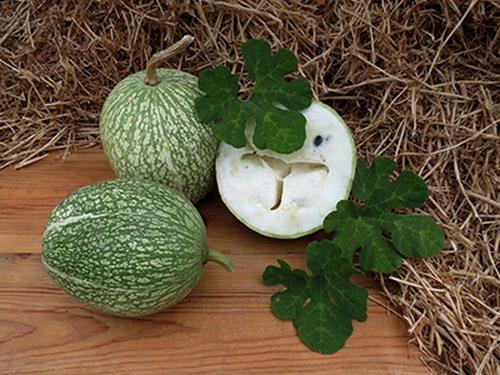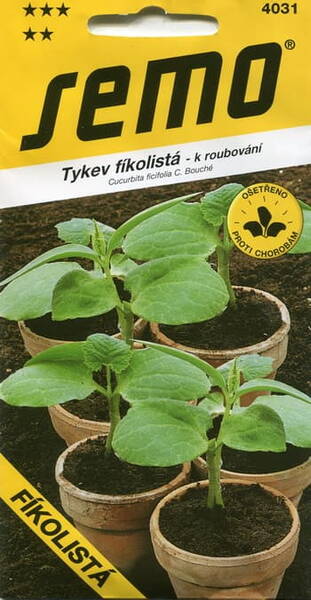Ex Tax: 2.45€
Fig-leaved pumpkin (Fig pumpkin, black-seeded pumpkin, ficephalia) - rootstock for grafting cucumbers, melons and watermelons.
Fig squash is a true miracle of life's prosperity. Its distinguishing feature from other squashes is its black, flat seeds (like those of a watermelon).
* Fig-leaved pumpkin (fig-leaved gourd) is an ancient, high-mountain, perennial plant (in our northern climate it is grown as an annual).
Homeland: South and Central America.
It does not cross with other pumpkins.
Its leaves are shaped like fig leaves with light spots on a greenish-blue and decorative leaf blade.
Phycephalia grows very quickly—in warm weather, the stem can grow 15 cm or more per day. It can be used to decorate fences, gazebos, sheds, dead trees, etc., yielding a substantial harvest.
One plant can produce over 100 kg of fruit, which tastes like a mild melon.
The flesh of the phycephaly is very juicy and suitable for magnificent salads that can decorate any festive table; it can be used to make soups, and stewed phycephaly is simply delicious!
The pancakes made from pineapple are tender and delicious, and the pineapple jam made from pineapple is very similar in taste to real pineapple.

The genus Cucurbita has many wild perennial species: Cucurbita cordata , Cucurbita digitata , Cucurbita californica and others, but only one is known in cultivation: Cucurbita ficifolia , or fig-leaved pumpkin (black-seeded pumpkin, ficifolia). It is a perennial plant with a hard, woody, 5-sided stem, heart-shaped leaves, finely toothed at the edges, and an orange and yellow corolla; the fruit is oblong, often curved; the flesh is white, coarse, and moderately dry. The seeds are black and flat-oval.
The center of origin is Peru. The oldest remains of Cucurbita ficifolia and Cucurbita moschata , in the form of charred seeds, stalks, and fruit peels, were discovered in Peru and are over 5,000 years old. Similar-aged remains of Cucurbita pero were found in the Osotro caves in Mexico.
Fig-leaf pumpkin is resistant to root rot caused by soil-borne pathogenic fungi. Therefore, other cucurbits, particularly cucumbers, are often grafted onto this pumpkin variety, as they are particularly susceptible to these infections when grown intensively in protected conditions.
* At one time it was written that she was as sweet as a watermelon, but this is not true...
The truth is, this is a super-vine and extra-productive super-zucchini: thin vines stretch for tens of meters, taking over entire arbors and fences...
It begins to bear fruit at the end of summer.
Smooth oval "watermelons" with green and white speckles are amazingly beautiful and just as delicious.
But too much of a good thing isn't good ! In September, the bush goes wild and literally starts throwing fruit: they hang right on the vines, every meter or so: a nearly ripe, matte one, next to it a half-sized, shiny one, then a tiny, egg-sized one, and then a new one has already set...
The same old story gets tiresome: you can't impress the neighbors with a zucchini, it's a shame to throw it away, and when it's overripe—who needs it? And so it goes on until the frost! You can't help but see this impudent plant as a weed. But imagine what would happen if you managed to save the roots from the frost!
So what's the best way to use it? Figleaf pumpkin is the only known cultivated species of perennial pumpkin that is highly disease-resistant, so it's used as a grafting partner for other pumpkin species.
The Shark Fin Melon, Malabar Gourd, Fig-Leaf Gourd, Perennial Pumpkin, Chilacayote, Pie Melon, Fig Leaved Gourd. Bot. syn.: Cucurbita melanosperma A.Braun ex Gasp., Pepo ficifolia (Bouché) Britton.
* A unique property of the fig-leaf pumpkin has been discovered: ripe fruits can be stored for up to 3 years, while unripe fruits (with soft bark) can be stored until May of the following year.
A chance incident helped to reveal the secret of this "longevity": one day, while cleaning, the scab was scratched, and after five minutes, a sticky, thick sap began to ooze out, which quickly hardened, sealing the wound...
Recipes:
1. FIG-LEAF PUMPKIN SALAD WITH SMOKED FISH.
You will need: 2-3 boiled potatoes, 1 boiled egg, 100-200 grams of hot smoked fish or a can of good sprats, 100-150 grams of raw pulp, 100-150 grams of greens - parsley, celery, green onions, sour cream for dressing.
Grate the pumpkin pulp on a coarse grater.
Finely chop the fish (after removing the bones). Mash the sprats with a fork (after draining the oil).
Cut the potatoes into cubes.
Finely chop the egg.
Wash the greens thoroughly and chop finely.
Mix everything and season with sour cream. Salt to taste.
2. STEWED FIG-LEAF PUMPKIN.
You will need: 800 grams of phycephaly pulp, 1 onion, 2-3 cloves of garlic, 2-3 tomatoes or 2-3 tablespoons of tomato puree, dill, celery, parsley - 50-100 grams in total, vegetable oil - 2 tablespoons (or butter - 20 grams), 1 tablespoon of water.
Dice the pulp, place in a deep frying pan or saucepan, add 1 tablespoon of water, and add oil. Simmer over low heat for 5-10 minutes (until the juice appears).
Finely chop the onion, add to the phycephaly and simmer for another 5 minutes.
Finely chop the garlic, add it to the phycephaly, add tomato slices or tomato paste and simmer until done.
Finely chop the greens and sprinkle over the stewed feta, let it sit for 5 minutes.
If desired, you can cook the stewed kale with rice. To do this, add 1 cup of long-grain rice and 2 cups of water to a saucepan along with the kale. Bring to a boil over high heat. Continue as per the recipe: add onions, etc.
3. The pulp of the phycephaly can be dried, ground and added to soups, stews, and dough.












